Hot air oven
a technology of oven and hot air, which is applied in the field of hot air oven, can solve the problems of increasing running costs, occupying a lot of space, and increasing efficiency, and achieves the effects of reducing running costs, improving efficiency, and reducing the footprin
- Summary
- Abstract
- Description
- Claims
- Application Information
AI Technical Summary
Benefits of technology
Problems solved by technology
Method used
Image
Examples
first embodiment
[0026]FIG. 3 shows schematically a simplified side view of a baker's oven 301 of the type shown in FIG. 1 but provided with a cross-flow tube heat exchanger 303 with heat exchanger tubes 333 in accordance with the present invention.
[0027]As can be seen in FIG. 4, the heat exchanger tubes 433 have the same external shape as the conventional tubes, i.e. a cross-section with two straight and parallel long sides 357′ and 357″, separated by a distance D, and connected by a pair of short ends 359′ and 359″. In this embodiment of the invention the short ends are convex and have a diameter of curvature D. The thin tube wall 361 of each heat exchanger tube 333 is made of a material with good thermal conductivity and corrosion resistance, for example a metal such as pure or alloyed aluminium, copper or iron.
[0028]The interior of these heat exchanger tubes are provided with one or more—in this example two—longitudinally extending interior walls 363′, 363″. Each interior wall stretches from one...
second embodiment
[0029]FIG. 5 shows a cross-section through a pair of heat exchanger tubes 533 in accordance with the present invention. In this embodiment, the interior of these heat exchanger tubes are provided with one or more—in this example four—interior longitudinally extending walls 563′, 563″, 563″′, 563″″. Each interior wall stretches from one long side 557′ towards the opposite long side 557″ but does not contact it. This divides the heat exchanger tube into three open (i.e. there is nothing which prevents exhaust gas from flowing from one compartment into another compartment) elongated compartments 565′, 565″, 565″′ though which the exhaust gases flow. The innermost ends and / or the exposed surfaces of the interior walls may be roughened or shaped to induce turbulence in order to aid the transfer of heat energy from the exhaust gas to the interior wall.
[0030]FIG. 6 shows a cross-section through a second embodiment of a heat exchanger tube 633 in accordance with the present invention. In th...
PUM
 Login to View More
Login to View More Abstract
Description
Claims
Application Information
 Login to View More
Login to View More - R&D
- Intellectual Property
- Life Sciences
- Materials
- Tech Scout
- Unparalleled Data Quality
- Higher Quality Content
- 60% Fewer Hallucinations
Browse by: Latest US Patents, China's latest patents, Technical Efficacy Thesaurus, Application Domain, Technology Topic, Popular Technical Reports.
© 2025 PatSnap. All rights reserved.Legal|Privacy policy|Modern Slavery Act Transparency Statement|Sitemap|About US| Contact US: help@patsnap.com



